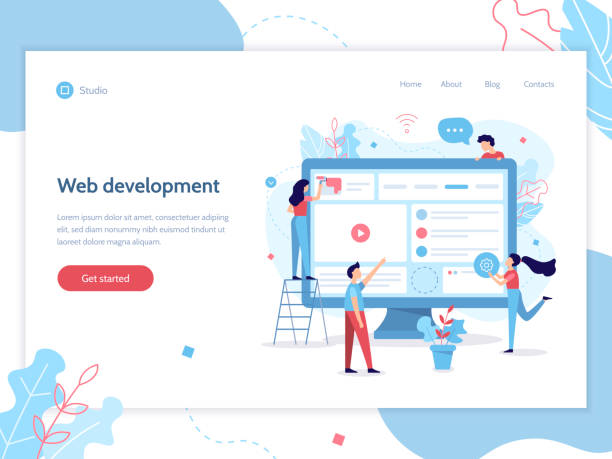Introduction to Responsive Web Design and Its Importance

In today’s world, where #digital_change is continuous and #users access web content from various devices, the concept of responsive web design has become more important than ever.
It is no longer enough to only display a website on a desktop; the widespread presence of smartphones, tablets, and even smartwatches has made a flexible design approach indispensable.
#Responsive_Web_Design (RWD) is a smart answer to this challenge, allowing websites to automatically adjust their layout and elements to the user’s device screen size.
This adaptability not only significantly improves user experience (UX) but also greatly assists with SEO and conversion rates.
The goal of this design type is to provide a seamless and optimal user experience, regardless of the device used.
In other words, users should not encounter problems such as horizontal scrolling, excessively small text, or disorganized images when switching between different devices.
This explanatory approach is equally important for users and developers and is the first step towards entering the advanced world of modern web.
From an educational perspective, understanding the fundamentals of responsive design is crucial.
This approach not only means resizing fonts and images but also involves a complete rearrangement of the layout, changing how menus are displayed, and even conditional loading of resources based on device characteristics.
A well-designed website using this method has high loading speed on mobile devices, provides easy navigation, and ensures access to information for all users, under any circumstances.
This flexibility makes your website resilient to future technological changes and the emergence of new devices.
In fact, responsive web design is an investment for the future that helps businesses maintain and enhance their position in today’s competitive landscape.
This specialized approach is not only technically advanced but also strategically essential for a successful online presence.
Are you concerned about your e-commerce website’s low conversion rate and not achieving your desired sales?
Rasawb is your specialized solution for a successful e-commerce website.
✅ Significant increase in conversion rates and sales
✅ Professional and user-friendly design to gain customer satisfaction
⚡ Ready for a transformation in online sales? Get a free consultation!
Technical Principles of Responsive Design: CSS Media Queries and Flexbox

The implementation of responsive web design is based on specific technical foundations, two of the most important being #CSS_Media_Queries and #Flexbox.
Media Queries allow designers to apply different CSS rules based on device characteristics such as screen width, height, orientation (horizontal or vertical), and even resolution.
For example, using a Media Query, you can define that on screens with a width less than 768 pixels, the website layout changes from three columns to one.
This dynamic capability allows the website to intelligently respond to different environments.
Media Queries are considered the backbone of any responsive design and provide unparalleled customization for displaying content on various devices.
In addition to Media Queries, the use of relative units like percentages (%), em, rem, and viewport units (vw, vh) instead of fixed units like pixels (px) is also crucial for creating flexible layouts.
Flexbox and Grid Layout are two powerful CSS layout systems that significantly simplify the process of building responsive layouts.
Flexbox (Flexible Box Layout) is designed for arranging elements in one dimension (a row or a column) and provides high flexibility for distributing space and aligning items.
This tool is very suitable for building navigations, product cards, and one-dimensional layouts.
For example, with Flexbox, items can be easily aligned in a row or automatically distributed within the available space.
On the other hand, CSS Grid Layout is ideal for two-dimensional layouts (rows and columns) and allows designers to create more complex structures with precise control over item placement.
Grid Layout is very powerful for the overall page structure (Layout) such as header, footer, sidebar, and main content.
By combining these techniques, dynamic layouts can be created that best adapt to any screen size.
This specialized and educational approach is the foundation of a successful mobile-friendly design, and understanding it is essential for any developer who intends to build modern websites.
These technical principles form the heart of responsive web design.
Countless Benefits of Responsive Web Design for Businesses and Users

In the current digital age, responsive web design is not merely a luxury feature, but a strategic necessity that brings extensive benefits to both businesses and users.
One of the most important advantages of this approach is improved user experience (UX).
A website that is properly designed to be responsive displays its content optimally without the need for zooming in, zooming out, or annoying horizontal scrolls.
This leads to a reduction in bounce rate and an increase in the time users spend on the site, as users can easily find the information they want and interact with the website.
A smooth and pleasant user experience is the main factor in customer loyalty and increased engagement.
From a business perspective, responsive web design is considered a smart investment with high returns.
Below, the table provides a comparison between the advantages of a responsive site and a non-responsive (old) site:
| Feature | Responsive Website Design | Non-Responsive Website (Old) |
|---|---|---|
| User Experience | Excellent on all devices | Poor on mobile devices |
| SEO | Higher score from Google, better ranking in mobile results | Lower ranking, Google penalty in mobile results |
| Maintenance and Updates | Management of a single codebase, lower cost | Requires managing two or more separate websites, high cost |
| Conversion Rate | Increase due to better UX and ease of access | Decrease due to difficulty of use on mobile |
| User Coverage | Access to all mobile, tablet, and desktop users | Limited access for mobile users |
Furthermore, a responsive website has significant improvement in SEO.
Google has explicitly stated that it prefers mobile-friendly websites and ranks them higher in search results.
This means more organic traffic for your website.
Also, managing a single codebase for all devices significantly reduces maintenance and update costs and simplifies the content publication process.
This analytical and guiding approach shows that responsive web design is not only an industry standard but also a powerful lever for business growth and sustainability in the digital environment.
Common Challenges and Solutions in Implementing Responsive Design

Despite its many advantages, implementing responsive web design is not without challenges.
One of the most important issues is #image_optimization for different devices.
High-quality images optimized for desktop can be very large on mobile devices and drastically reduce site loading speed.
The solution to this challenge is to use techniques such as “Responsive Images,” which include HTML5 features like the <picture> tag or the #srcset attribute.
This allows the browser to load the most appropriate image version based on the device’s screen size or resolution.
Additionally, using next-generation image formats like WebP, which offer better compression, can help reduce file size.
CDN (Content Delivery Network) is also very useful for faster delivery of images and other resources to users worldwide.
Another challenge is website #performance.
Mobile devices often have slower internet connections and weaker processors, so any loading delay can severely disrupt the user experience.
To counter this, #optimizing_CSS_and_JavaScript_code, minimizing HTTP requests, using caching, and lazy loading for images and videos are recommended.
Tools like Google PageSpeed Insights can help identify performance bottlenecks.
Also, it is sometimes questionable whether a “Mobile-First” approach should be adopted.
The mobile-first approach means that website design begins for the smallest screens (mobile) and then gradually expands to larger screens (tablet and desktop).
This approach naturally leads to lighter code and better performance on mobile, as only essential styles are loaded.
Controlling fonts and typography can also be challenging, as fonts must remain legible and aesthetically pleasing at various sizes.
Using relative units for font sizing (such as rem or vw) and choosing fonts that retain their clarity even in small dimensions is a solution to this problem.
Finally, debugging and testing #responsive_design across different browsers and devices require time and appropriate tools.
Using emulators and real devices for precise testing is essential.
This section provides important guidance for developers to best manage technical challenges and implement a successful responsive web design.
Are you worried that your company’s old website will drive away new customers? Rasawb solves this problem by designing a modern and efficient corporate website.
✅ Increases your brand’s credibility.
✅ Helps attract targeted customers.
⚡ Contact Rasawb for a free consultation!
Popular Tools and Frameworks for Responsive Web Design

To facilitate the process of responsive web design and increase development speed, numerous tools and frameworks are available that greatly simplify the work of designers and developers.
One of the most well-known and widely used CSS frameworks is #Bootstrap.
Bootstrap is a comprehensive collection of ready-to-use UI components, a flexible grid system, and JavaScript plugins that enable designers to quickly build responsive and modern websites.
By providing predefined CSS classes, this framework turns the responsive design process into a simple operation; so much so that even individuals with less knowledge can design professional-looking websites compatible with various devices.
Bootstrap 5 is even more advanced and works without jQuery, which significantly helps improve performance.
In addition to Bootstrap, other frameworks exist, each with its own advantages.
#Foundation is another advanced HTML, CSS, and JavaScript framework that focuses more on flexibility and customization, suitable for larger and more complex projects requiring precise control.
#Bulma is a modern CSS framework based on Flexbox, which has gained popularity due to its simple syntax and modularity.
For those seeking lighter solutions, smaller frameworks like Milligram or Pure.css are suitable options that include only the minimum necessary CSS for responsive design and allow for more customization.
In terms of development tools, modern browsers like Google Chrome and Mozilla Firefox have built-in Developer Tools that provide the ability to simulate various devices and test website responsiveness.
These tools allow viewing the website at different screen sizes, changing orientation, and even simulating slow network connections, which is very useful for debugging and optimization.
For larger projects, Content Management Systems (CMS) like WordPress, Joomla, and Drupal have also made building and managing mobile-friendly websites much easier with strong support for responsive themes and specialized plugins.
These tools and frameworks provide a specialized approach and practical guidance for developers to best implement responsive web design.
The Role of Content in Responsive Design: Adaptability and Accessibility

When it comes to responsive web design, the focus is usually on visual aspects and layout, but the role of #content in the success of a responsive website is equally vital.
Content must not only visually adapt to the screen size but also be adaptable semantically and structurally for an optimal user experience across various devices.
For example, a long paragraph that is easily readable on a desktop might tire a user on a small smartphone, leading to endless scrolling.
Therefore, content writers should think about #adaptable_content that can be easily condensed for display on smaller dimensions or broken down into smaller sections.
Using subheadings, bulleted lists, and short paragraphs can improve readability on mobile devices.
Another important aspect is #content_accessibility.
A responsive website must be accessible to all users, including those with disabilities.
This means adhering to WCAG (Web Content Accessibility Guidelines) standards.
For instance, using semantic HTML tags (such as <header>, <nav>, <main>, <footer>), alternative text for images (alt text), and ensuring that all elements are keyboard-accessible are crucial.
In mobile environments, where interaction is touch-based, sufficient size for buttons and links, and appropriate spacing between them to prevent touch errors must also be considered.
These explanatory and educational considerations are essential for designing a truly inclusive website.
Furthermore, content loading must be done intelligently.
For example, heavy videos and image galleries should not be immediately loaded on mobile devices with slow connections.
Instead, Lazy Loading can be used to load these elements only when the user scrolls to them.
Additionally, advertising content and pop-ups should be designed not to disrupt the user experience on small screens and to not occupy too much space.
Finally, UX Copywriting plays a crucial role in guiding users across different devices.
Short and clear messages, distinct Call-to-Action buttons, and simple instructions all help improve user interaction with the responsive website.
This integrated approach to content and design ensures the success of a responsive web design.
Successful Case Study in Responsive Web Design

To gain a deeper understanding of the impact of responsive web design, let’s examine a hypothetical case study.
“Novan Tech,” a leading startup in cloud services, faced the problem of declining mobile traffic and low conversion rates on its old website.
Their previous website was optimized for desktop and provided a very poor user experience on smartphones.
Texts were small, images were disorganized, and navigation was complex.
As a result, mobile users quickly left the site, negatively impacting the company’s SEO ranking and revenue.
This situation created a challenging question for Novan Tech’s marketing team: how could they strengthen their online presence in the mobile era?
The Novan Tech team decided to completely redesign their website with a responsive web design approach.
This project took six months and involved deep analysis of user needs, content revision, and new implementation using modern frameworks and a mobile-first approach.
They implemented image optimization using srcset and utilized lazy loading techniques for heavy content.
The results after launching the new website were impressive, and you can see a summary of these achievements in the table below:
| Metric | Before Responsive Design | After Responsive Design | Change |
|---|---|---|---|
| Mobile Traffic | 15% of total traffic | 40% of total traffic | 166% Increase |
| Mobile Bounce Rate | 75% | 30% | 60% Decrease |
| Mobile Conversion Rate | 0.5% | 2.5% | 400% Increase |
| Average Time on Site (Mobile) | 45 seconds | 2 minutes and 30 seconds | 233% Increase |
| SEO Ranking (Mobile-related keywords) | Lower than first page | Top rankings on first page | Significant Improvement |
This news and analytical case study shows how a responsive web design not only improves the user experience but also directly impacts key business performance indicators (KPIs).
Increased traffic, reduced bounce rate, and especially the significant leap in conversion rate, are testaments to the power of this approach.
Novan Tech was able to dramatically increase its market share in the mobile sector and become a successful example in #digital_marketing and #branding in the online space.
This is an engaging yet informative example of the power of responsive design.
The Future of Responsive Web Design and Emerging Trends

As technology rapidly advances, responsive web design is also evolving, and new trends are emerging that are shaping the future of the web.
One of the most important of these trends is the expanding use of #PWA (Progressive Web Apps).
PWAs offer a combination of the best features of websites and native mobile applications; they can be installed on the device’s home screen, provide offline access to content, and send Push Notifications, while still being built on web technologies and not requiring downloads from app stores.
These capabilities significantly improve user experience and turn websites into more powerful and accessible tools.
A PWA that is correctly built with the principles of responsive web design can perform optimally on any device.
Another trend is the increasing emergence and development of #AMP (Accelerated Mobile Pages).
AMP is an open-source framework developed by Google to create very fast web pages on mobile devices.
The main goal of AMP is to deliver content instantly on smartphones so that users have an unparalleled loading speed experience.
Although AMP has some design limitations, it is very effective for news content and blogs and can attract significant traffic to the website through mobile search.
Combining AMP with responsive design can allow your website to have unparalleled speed and flexibility.
Furthermore, the growth of #Dark_Mode in operating systems and applications has led designers towards creating dark versions of websites.
A responsive design in the future should be able to dynamically switch between light and dark modes based on user settings, and this is a new analytical aspect in UX/UI.
Other trends, such as Web Components for building reusable UI elements, increased use of CSS and JavaScript-based animations to enhance visual appeal without harming performance, and the growing importance of Micro-interactions to improve user feedback, are also taking shape.
Moreover, #responsive_design extends beyond screens and is adapting to wearables and even the Internet of Things (IoT).
In the future, websites must be able to optimize their content and services for voice experiences and even Augmented Reality (AR).
These news and analytical trends indicate that responsive web design is a dynamic and ever-evolving field that gains new dimensions with every technological innovation.
Are you worried that your company’s old website will drive away new customers? Rasawb solves this problem by designing a modern and efficient corporate website.
✅ Increases your brand’s credibility.
✅ Helps attract targeted customers.
⚡ Contact Rasawb for a free consultation!
Key Tips for Choosing a Professional Responsive Web Design Team

Choosing the right team or individual for your responsive web design project is a crucial decision that can determine the success or failure of your online presence.
Given the technical complexities and user experience considerations, this is an investment that must be made carefully.
The first and most important tip is to review their portfolio.
A professional team should have a strong and diverse portfolio of their previous responsive projects.
Look for websites that display well on various devices (mobile, tablet, desktop) and provide a smooth user experience.
Pay attention to the #design_quality, #loading_speed, and #ease_of_navigation in their portfolio.
This specialized evaluation will give you a good insight into the team’s capabilities.
Another key point is the team’s #technical_expertise.
Ensure that the chosen team has full mastery of core responsive web design technologies such as CSS Media Queries, Flexbox, CSS Grid, and image optimization (like srcset and WebP).
Also, their knowledge of mobile SEO principles and Web Performance is very important.
Ask them about their approach to mobile-first design and the tools they use for testing and debugging.
An experienced team should be able to provide creative solutions for challenges such as content loading or managing large data across different devices.
This is a challenging content piece, and you should carefully evaluate the team’s responses.
The team’s communication skills and ability to understand your business needs are also very important.
They should be able to clearly explain ideas and project progress to you without complex technical jargon.
The team should answer your questions and guide you throughout the design and development process.
Reviewing previous client feedback and the team’s reputation in the market can also help you make an informed decision.
Transparency in costs and project timeline is also of high importance.
The team should provide a clear work plan and a realistic timeline.
Finally, look for a team that not only designs a responsive website for you but also acts as a strategic partner that contributes to the long-term growth of your business.
This is comprehensive guidance to ensure the right choice for responsive web design.
Conclusion and Why Responsive Web Design Is a Necessity

In conclusion of this article, it can be definitively stated that responsive web design is no longer an option, but an undeniable necessity for any business, organization, or individual who wishes to have an effective online presence.
#Responsive_web has fundamentally changed how users interact with online content, and websites must embrace this change to succeed in today’s competitive digital world.
From an analytical perspective, its countless benefits, from improving user experience and increasing conversion rates to enhancing search engine rankings and reducing maintenance costs, all bear witness to the fundamental importance of this approach.
Ignoring responsive design means losing a huge portion of mobile users, who are increasing day by day, and this translates to losing numerous business and communication opportunities.
As discussed in this explanatory article, strong #technical_principles like Media Queries and Flexbox/Grid, and tools such as Bootstrap, have made implementing this type of design easier than ever.
However, challenges like image optimization and performance also exist, which can be overcome with correct approaches.
The future of the web is moving towards more integrated and faster experiences, and emerging trends like PWA and AMP also emphasize the importance of adaptability and speed.
This indicates that responsive web design is not a fixed concept, but a dynamic and evolving process that requires continuous updating of knowledge and skills.
Ultimately, for any business, #investing in responsive web design is a strategic and long-term decision.
This investment not only helps attract and retain customers but also makes your website resilient to future technological changes and keeps it relevant and efficient for years to come.
If you want to be a leader in the #future_of_web and ensure that your content reaches your audience in the best possible way on any device, implementing a strong and intelligent responsive design is an undeniable necessity.
This is definitive guidance for anyone who wants to succeed in the modern digital world.
Frequently Asked Questions
| Question | Answer |
|---|---|
| What is Responsive Web Design? | A method for website design that ensures the website displays well and provides a suitable user experience across various screen sizes and devices (such as mobile, tablet, desktop). |
| Why is responsive design important? | Improved user experience, better SEO (Google prefers responsive sites), saving time and cost (no need to build a separate site for mobile). |
| What are the main techniques in responsive design? | Using fluid grids and layouts, flexible images and media, and employing CSS Media Queries. |
| What are Media Queries in responsive design? | A part of CSS3 that allows you to apply different styles based on the characteristics of the device on which the website is displayed (such as screen width, resolution, media type). |
| What are the benefits of using responsive design? | Access to more users (especially mobile), improved user engagement rate, reduced maintenance costs (one site for all devices), and improved Conversion Rate. |
And other services of Rasa Web Advertising Agency in the field of advertising
Smart Google Ads: A combination of creativity and technology to increase sales through custom programming.
Smart Social Media: A creative platform to improve online growth with custom programming.
Smart SEO: Transform online growth with the help of Google Ads management.
Smart Content Strategy: A creative platform to improve customer behavior analysis with marketing automation.
Smart Marketing Automation: A creative platform to improve campaign management with key page optimization.
And more than a hundred other services in the field of internet advertising, advertising consultation, and organizational solutions
Internet Advertising | Advertising Strategy | Advertorial
References
Responsive Web Design: A Comprehensive Guide
The Future of Web Technologies
History and Evolution of the Web
The Digital Future and the Role of Website Design
? To elevate your business in the digital world, Rasawb Afarin Digital Marketing Agency, specializing in SEO, online advertising, and custom website design, is your reliable partner.
📍 Tehran, Mirdamad Street, next to Bank Markazi, Kazeroun South Alley, Ramin Alley, No. 6

